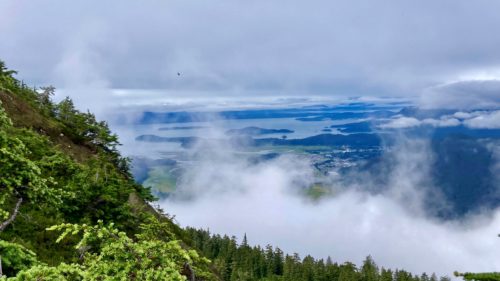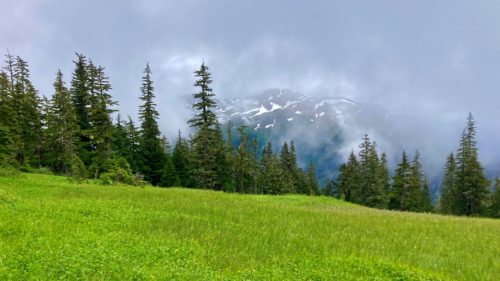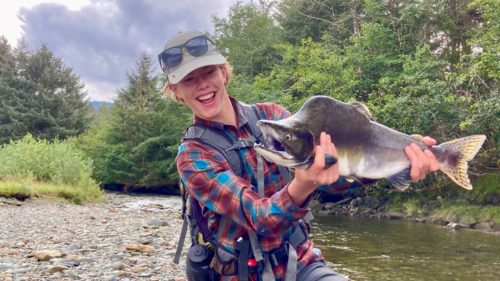
Southeast Alaskans’ Climate Change Conversations Could Shape Region


The following appears in the September issue of Alaska Sporting Journal:
BY CHRIS COCOLES
Aaron Kindle knew that his fieldwork picking the brains of resident sportsmen and -women had taken him to a special place.
Kindle, National Wildlife Federation Outdoors director of sporting advocacy, joined his colleague, NWF Outdoors’ sporting communications coordinator Mandela van Eeden, in Southeast Alaska to get a feel for how the area’s hunters and anglers are bracing for the potential effects of climate change in what could be North America’s most diverse and fragile ecosystem.
What the visitors took away from their time on the Alaska Panhandle was not only that so many they met will fight to protect these lands, but these same lands are without a doubt worth preserving.
“We spent a lot of time with folks who are witness to this stuff. We talked to people who are on fishing boats. People who are hunters and fishers up there and heard about the changes that they’re seeing and what they are concerned about. How their community is talking,” says Kindle, who’s based in Colorado.
“We spent a day on a commercial fishing boat and spent some time on docks talking to commercial fishermen. We spent time in the woods speaking with hunters. We did roundtable events and brought members of the community that are on some of the advisory councils and are dealing with these issues, like the mayors. The field time was really just talking to individuals who are dealing with this first-hand.”
FROM ITS GLACIERS TO its rugged mountains, temperate rainforest to spectacular islands – amid the backdrop of 17 million acres worth of pristine Tongass National Forest land, which is about the size of West Virginia – you couldn’t find a more compelling region to study the effects of climate change. There’s just so much going on ecologically in this corner of the Last Frontier.
“I think one of the interesting things to me about Southeast was the isolation in that you’re basically on these strips next to the ocean, and then everything from there on up is glaciated or surrounded by the ocean. And there’s very little place to move around, really,” Kindle says.
“I’m in Colorado and it’s not too crazy for us to think, ‘Hey, let’s drive 200 miles (somewhere).’ There, I think in Juneau, the road system is something like 45 miles, and around Sitka it’s 12 miles. So just that was really interesting and then, of course,
just seeing a temperate rainforest and everything that grows – how green it is. And then the quick transition right up to glaciers and really high country.”
In reality, the entire state of Alaska is the quintessential case study.
“The further north you go, the more serious and the gravity of climate change you’ll see, because you’ve got Alaska, which has gone up about 3 degrees in the past 50, 60 years, and looking at another couple degrees in the next couple of decades,” Kindle adds. “You’re seeing what that means, and sometimes it doesn’t seem like a lot.”
Kindle and van Eeden got a small taste of the landscapes around Juneau, Sitka and the Tongass. They got in some fishing, both at sea for halibut (they didn’t have any luck with the big flatfish) and coho (they did land some silvers) and in the mouths of rivers, where they fly fished for pinks.
They also went on hikes, spotting some of the local fauna – bears, mountain goats, “tons of bald eagles” – and took in first-hand views of some spots that could show signs of climate change impacts.
“We saw a lot of cedar die-off in the area I was in. Locals tell me that cedars need a little snow on the ground to protect their root system. When you see a couple of degrees’ difference, Southeast Alaska is right on that freezing mark a lot of times in the winter,” Kindle says. “So if you’re talking about it’s 30 degrees compared to 32 or 33 and that snow isn’t over those roots because it’s falling as rain or it’s melting out faster, you see things like cedar die-off.”
The nearly statewide struggles of Alaska’s king salmon stocks is also a concern on the Panhandle. Changing ocean conditions have meant smaller- sized kings returning to their spawning streams. Smaller salmon carry fewer eggs and also aren’t able to dig redds as deeply as bigger fish. Kindle also cited Dall sheep losing some of their food sources – like lichen and mosses – that are being iced over rather than snowed upon. Alder is said to have “creeped up the mountainside in what used to be grassland types of areas,” which in turn is restricting the availability of forage for the critters.
“There are things that are pretty hard to grasp on the surface for a regular Joe or Jane,” Kindle says. “There are a lot of different variables that are hard to kind of understand. One of the things we tell people is that no matter where we go across the country, the main thing we hear is that things are just a little bit weird. And it’s hard to necessarily put a finger on it, because ecology is complicated. But everyone says things are changing; ducks aren’t doing the same thing and they’re not migrating the same way; vegetation is changing; and precipitation patterns are changing.”
“The one thing about this was it echoed what we heard in other places,” Kindle reiterates about his Alaska trip. “Things are changing.”
And not for the better, sadly.

ONE OF THE MOST frustrating aspects of detailing the potential consequences of climate change is the skeptics who don’t buy what the experts see and the public at large acknowledges is occurring. Then again, Kindle’s gotten used to the notion that not everyone will be onboard with his opinion that “things are changing.”
“In our line of work we’ve got thick skin. I don’t get too worried about it, but the science is pretty damn clear. We’re seeing these issues, and even for someone who doesn’t want to call it climate change, they know there are problems. And we invite them to be a part of the solution,” Kindle says. “And
I think one of the coolest things that we have an opportunity with – and all of us who care about the outdoors – is natural climate solutions and climate resilience work. And I say that because those things improve fish and wildlife habitat. And that improves hunting and fishing.”
Still, some in important positions, such as members of Congress, have refused to or at best not acknowledged that something sinister has accounted for events like increasing wildfires, which in recent years have wreaked havoc in drought-stricken Western states. Blazes have also burned throughout Alaska this summer, including the second largest amount of land scorched in June, which accompanied a record-dry late spring.
“One thing about being outdoors people is we’re used to living through adversity. What’s most heartbreaking is people who don’t want to acknowledge it. Because that’s the first step to doing something about it. ‘We’ve got some issues. What are we going to do about it?’” Kindle says. “And for me, particularly the hunting and fishing communities, we’re out there all the time. We see this stuff. We’re the ones who return to landscapes year after year and see how they change over time and how animal behavior is changing – more than people who don’t do this.”
“When people are seeing those things and say, ‘Well, things just change,’ even though the science is right next to them saying, ‘Well, things are changing because of this.’ To get folks to kind of accept and then start talking about it and forge solutions with our knowledge, that’s kind of what this is all about.”

FOR KINDLE AND VAN Eeden, who lives in Montana, the interaction between themselves and those commercial fishers and subsistence hunters proved to be worth the trip in terms of getting a perspective on just what’s going on in Southeast Alaska.
NWF Outdoors hosted a community forum in Juneau, with sportsmen and -women and those who rely on the natural resources weighing in on issues in their backyard.
When they were out seeking coho, the talk was that the fish were late arrivals during the usual August run. Kindle is quick to point out that he can’t necessarily blame salmon tardiness on climate change.
“I can’t do that, but it is indicative of things changing and that just kind of follows the form of what we’re hearing up there. No matter where we go or who we talk to, it’s that things are off,” he says. “The timing of migration and when things show up. When plants start budding or when fall comes and the snow comes. All of those different timing things are something we hear every time we go (out in the field).”
The sprawling Tongass was also on the minds of the locals. As its old growth is threatened and the Roadless Rule has been under assault to potentially allow large-scale logging, America’s most massive national forest is a hot-button topic in these parts.
Kindle got just a small taste of the Tongass, but he called it a “really unique place.” And who could blame any first-time visitor for being in awe of its changing landscape, from the sea up the steep cliffs of the high country? It’s the Alaska that Lower 48ers see in their dreams, Kindle included.
“It’s one of the biggest and most productive national forests, and the biggest in the United States. And obviously logging has been part of its history. I think like any of these natural resources decisions, a lot of what people want is certainties,” he says. “They want to know what’s going to happen and they don’t like to flip-flop around. ‘We have to protect this, this year and next year with administrative changes.’”
Kindle and van Eeden hosted an episode of the National Wildlife Federation Outdoors podcast (nwfoutdoors.org). Joining them were two badass women of Southeast Alaska, Jodee Dixon, an ambassador for Artemis, a sportswomen’s advocacy organization, and Meredith Trainor, the executive director of the Southeast Alaska Conservation Council.
“Incredible people who live it and do it and breathe all this stuff. They’re like a lot of people that we get to talk to, fortunately for us. They know what they’re talking about. They spend their time on the landscape,” Kindle says. “They advocate for this stuff. They take care of this place. They know animal behavior. And that’s what we love about our opportunities to talk to people like these. They’re incredible and undeniable in their knowledge.”
Van Eeden opened the podcast by saying how fortunate she was to be a part of the local community for even a short period of time.
“And to help gather and share some of the storytelling that happens in this part of the world,” she added. “We’ve been sitting around fires for thousands and thousands and thousands of years sharing stories. A lot of times it involves hunting and fishing. And in this part of the world I’m amazed by the abundance here.”
During their conversation with the hosts, Dixon and Trainor both expressed the urgency when it comes to not losing all the gifts Mother Nature provided to Southeast Alaska and the entire state. Preserving that legacy of subsistence hunting, fishing and foraging is a way of life.
“I feel like the local food circumstance is going to change everywhere,” Trainor told Kindle and van Eeden. “And I hope that local food becomes more and more popular … Things are changing, so if what you would normally fish or hunt changes, we evolve and we start hunting and fishing (for) other local food that is abundant.”
Trainor said that harvesting the local fish and game on its own can help combat the inevitability of further shifts in the ecosystem due to climate-related phenomenon. Then there’s challenging politicians on both sides of the aisle to work together to brace for further shifts in the climate.
Dixon hoped new climate change warriors would enter the chat and connect with Alaskans like herself and Trainor.
“I would support anyone who feels like they’re just getting into this realm,” she said. “It feels overwhelming, or the changes you feel that need to happen feel insurmountable. You just don’t know where to start. Start with just one thing; pick an organization that you can start to engage with.”


KINDLE RETURNED TO COLORADO and van Eeden to Montana with even more motivation to continue the work of preserving these lands for hunters and anglers of current and future generations.
“More than anything, you can’t make pristine habitat. You’re not getting any more of it. So the easiest way to keep these ecosystems healthy is to keep them intact. So if you have these large intact ecosystems, the best way to take care of them is to let them be,” he says.
“I think it’s like I say all the time: With all this privilege we have in this country with our natural resources, we have an obligation to take care of them and to get engaged. Kind of gone are the days when you can just head out in the field in the fall or wherever you’re fishing and just expect that the landscape you return to every year is going to be in great shape year after year. There are just too many things, whether it’s climate issues, development, energy; so many different things are coming down the pipe that can impact our natural resources.” ASJ
Editor’s note: For more info, check out the websites of National Wildlife Federation Outdoors (nwf.org/outdoors), Southeast Alaska Conservation Council (seacc.org) and Artemis (artemis.nwf.org).



